Failures in the construction of real property are called construction defects in the law and in the construction industry. An overview of the different types of construction failures and construction defects is helpful to understanding what construction failures and defects are as well as the claims and remedies that can be pursued by an owner of real property that is affected.
Construction Failures and Defects in the water-proof Building Envelope
Construction failures and defects are essentially areas where the construction does not perform as intended and therefore does not adequately fulfill its function and purpose. One of the most obvious and essential functions of any construction, commercial or residential, is to provide a waterproof, sealed barrier against the elements, particularly water leaks, leaks and water intrusion due to rain, moisture, even water condensation in the interior and walls of the building. This is often referred to as the building “envelope”, a water-tight moisture barrier that maintains a dry and climate-controlled environment for the entire interior of the building, as well as the adjacent and connecting components such as the walls and wall cavities, foundations, slabs, exterior siding and stucco, retaining walls and drainage systems.
Construction Standards Overview
The standards for maintaining the waterproof building envelope exist in the building codes, in the industry standards and in product manufacturing standards that apply to every component of a structure including windows and doors, decks, roofs, exterior walls, stucco and plaster, retaining walls, subsurface structural walls and any subsurface walls, basements and foundations. Every plan, design and architectural and structural plan that is approved by any governmental authority must comply with these standards. A failure of the building envelope or any component in any way that fails to contain and prevent water to pass is a construction defect.
These standards have been incorporated into various laws in California, including Civil Code § 896, which is appropriately entitled, “Building Standards for Original Construction Intended to be Sold as an Individual Dwelling Unit.” Although these standards are contained within the “Right to Repair Act”, it’s important to note that where the right to repair does not apply, such as when the builder fails to give proper notice to the buyer, or to properly record the notice of the right to repair law on the title for the property, the building standards of 896 still apply, and would otherwise simply be a description of the industry and building code standards that also apply.
Construction Standards: Water Issues
Section 896 contains an extensive list of building standards that apply to “water issues”, that is issues related water intrusion, listing a series of building components, doors, windows, patio doors, decks, deck doors, balconies, balcony systems, exterior stairs and stair systems, foundations, slabs, retaining walls, hardscape, irrigation and drainage systems, stucco, exterior siding, exterior walls and framing and waterproofing systems behind or under ceramic tile and countertops, as well as plumbing, sewer, showers, baths and all related components shall not allow water to pass beyond, around or through, shall not allow moisture or excessive condensation through and shall not leak. This standard is abundantly clear: the building and all its components shall not leak, period. If leaks, water intrusion, water moisture, water vapor, excessive condensation occurs, this is a construction failure and a construction defect.
It is also important to note that if this standard is not met, and leaks exist, this is a sign that the builder failed to adhere to the most important and obvious building standards and may be a sign that there are other areas of the building that may be defective as well.
Construction Standards: Structural Issues
Section 896 also covers structural issues. With respect to structural issues, the foundations, load bearing components and slabs shall not contain significant cracks or significant vertical displacement, nor shall the foundations, load bearing components and slabs contain significant cracks or cause the structure in whole or in part to be structurally unsafe. The foundations, load bearing components, slabs and underlying soils shall be constructed so as to materially comply with the design criteria set by the applicable government codes, regulations or ordinances for chemical deterioration or corrosion resistance, as well as meet all design criteria for earthquake and wind load resistance.
With respect to soils issues: The soils and engineered retaining walls shall not cause damage to the structure built upon the soil or retaining wall, shall not cause the soils or engineered retaining wall to be structurally unsafe or cause the land upon which the structure is build to become unusable for the purpose represented at the time of original sale or for which the land is commonly used.
Construction Standards: Other Standards
The additional areas covered by these standards include fire protection, including fireplaces and chimneys, plumbing and sewer issues, electrical systems, and other areas of construction including exterior pathways, hardscape and sidewalks, stucco, exterior wall finishes, which shall not contain significant cracks or separations. Other components, such as manufactured products, roofs, electrical fixtures, HVAC units, cabinets, paint and appliances shall be installed so as to not interfere with the product’s useful life, or utility. Heating shall be capable of maintaining a room temperature of 70 degrees in living spaces and 68 degrees in all habitable rooms. Living space air conditioning shall be provided in a manner consistent with the size and efficiency design criteria specified in Title 24 of the California Code of Regulations.
The standards include other detailed items, but the foregoing are the more significant and potentially serious of the defects and failures to be considered.
Construction Failures Defects and Statutes of Limitation
If you have experienced any of the foregoing failures or issues, it is important to promptly take action in order to protect your rights. There are a number of rather complex and overlapping statutes of limitation that apply, which, depending on the facts of each individual case could limit or bar your claim. If you are aware of any of these construction failures, contact Timothy Norton of Norton & Associates today to determine the course of action necessary to protect your home and your investment.
Timothy Norton of Norton & Associates, Los Angeles Real Estate and Construction Defect Attorney, has 34 years of experience in construction defect litigation, with $190m in jury verdicts, $70m punitive damage verdict, and millions more in settlements.
For a consultation and case evaluation, call: 310.706.4134, or email to: [email protected] today. Protect your investment.


